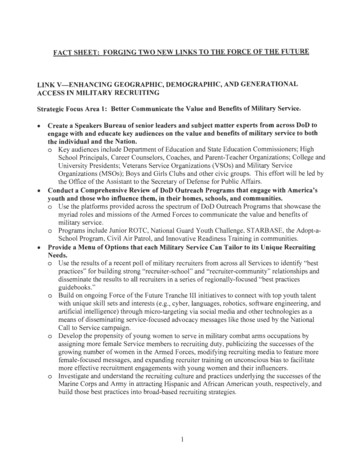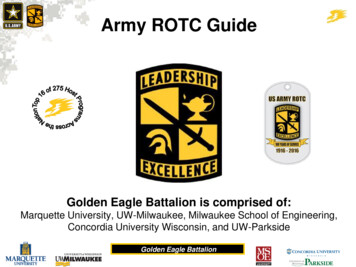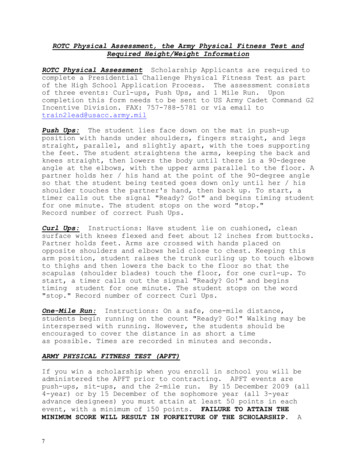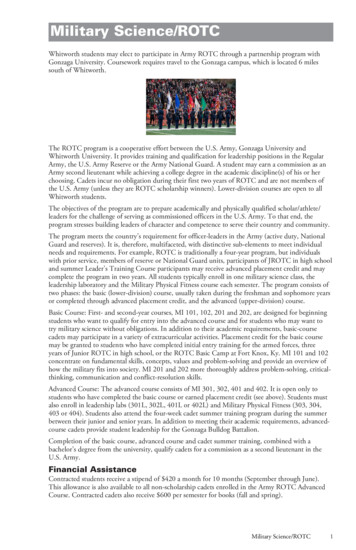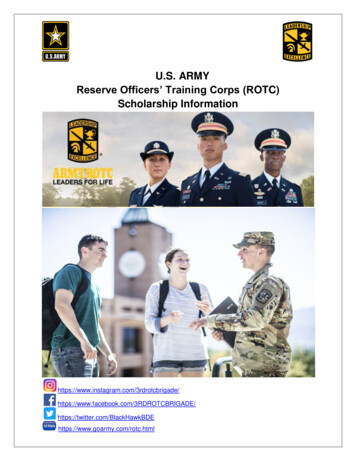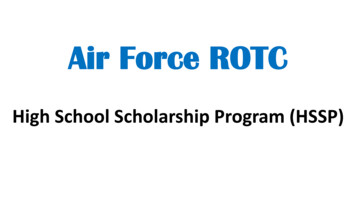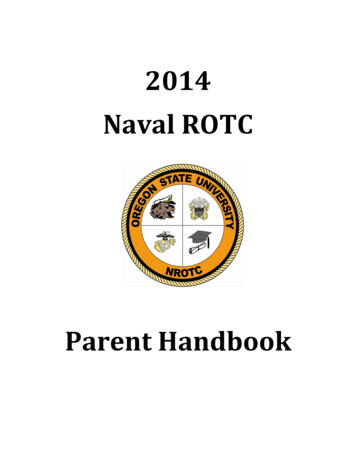
Transcription
2014Naval ROTCParent Handbook
Naval Reserve Officers Training CorpsParent HandbookTable of ContentsCommanding Officer’s Welcome . 1NROTC Mission Statement. 2New Student Orientation . 2USN Physical Readiness Test (PRT) Standards for males . 3USN Physical Readiness Test (PRT) Standards for females . 4USMC Physical Fitness Standards (Males) . 5USMC Physical Fitness Standards (Females) . 5Height and Weight Standards . 6Program Requirements . 7Academic Requirements . 7Summer Training . 8Physical Training. 9Option Specific Requirements . 9Monetary Benefits . 10Scholarship Students . 10College Program Students. 10Room and Board . 11Tutoring . 11NROTC Policies . 12A Student’s Right to Privacy - Family Education Right to Privacy Act (FERPA) . 12Drug Policy and Urinalysis . 12Alcohol Policy . 12Participation in Battalion Activities . 13Priorities . 13Have Fun . 13Interaction with Advisors . 13Changes in Status . 14Good Standing . 14Warning – Academic/Aptitude . 14Probation – Academic/Aptitude . 14Performance Review Board (PRB) – Academic/Aptitude . 14Leave of Absence (LOA) – Academic/Aptitude/Medical . 15Disenrollment and Recoupment . 15Clubs and Activities . 16Group Activities . 16Community Service . 16Semper Fidelis Club . 16Aviation Club . 17ii
Naval Reserve Officers Training CorpsParent HandbookSubmarine Club . 17Surface Warfare (SWO) Club . 17Battalion Events . 17Joint Service Review (JSR) and Spring Awards Ceremony . 17Northwest Navy . 18NROTC Annual Recurring Events. 18Life after NROTC. 19Service Assignment . 19Commitment . 19Glossary of Terms and Abbreviations . 20Naval ROTC Staff Directory . 22iii
Naval Reserve Officers Training CorpsParent HandbookCommanding Officer’s WelcomeWelcome Aboard!Your son or daughter is about to embark on a pivotal chapter in life – the undergraduatecollege experience – and will be making choices over the next four years about his or heracademic major, extracurricular activities, and future service in the U.S. Navy and MarineCorps.This handbook is designed to help you as parents find answers to your questions regardingthe program and the lifestyle that your midshipman has chosen; our activities, policies, andthe commitment made by your son or daughter following their graduation andcommissioning. I hope that you find it helpful and that you will keep it as a reference asquestions arise.This year’s freshman class has already made an important choice – to participate in theNaval Reserve Officers Training Corps (NROTC). This educational pathway will bothencourage and motivate them to connect with knowledgeable faculty and advisors whohave been specifically selected from the fleet to work with your midshipman. Please knowthat your continued support and encouragement will make a tremendous impact upon thesuccess of your student.We want to welcome you to our Navy and Marine Corps family; and as always, if you havefurther questions or concerns, please contact our staff. I’m sure you will find themextremely helpful.R. K. WOOD IICAPT, USNCommanding Officer, OSU NROTC1
Naval Reserve Officers Training CorpsParent HandbookNROTC Mission StatementTo develop midshipmen morally, mentally, and physically, and to imbue them with the highest ideals of duty,honor and loyalty, and with the core values of honor, courage and commitment in order to commissioncollege graduates as naval officers who possess a basic professional background, are motivated towardcareers in the naval service, and have a potential for future development in mind and character so as toassume the highest responsibilities of command, citizenship and government.New Student OrientationOur NROTC New Student Orientation (NSO) is structured to provide entry-level familiarity with military lifeand the NROTC program in particular. It is not boot camp or a weeding out period – we want everyone to besuccessful. The adjustment into a military environment can be stressful and NSO will be a challenge for yourson or daughter. We will put them in stressful situations so that they will learn how to deal with militarystress, and to teach them that they can deal with many different types of stress. We do not expect that newmidshipmen will emerge from this training as fully polished military personnel, but we do expect to establisha solid foundation for the learning, growth, and opportunities that the next four years will present.Specifically, NSO affords us the opportunity for: Issuance of uniforms and basic indoctrination in Navy uniform regulations and grooming standards.Instruction in the basics of military customs, courtesies, traditions, and organization, including unitregulations and chain of command.Acquisition of basic competency in military drill and ceremony.Physical Fitness Training to determine the midshipman individual level of readiness to meet NROTCprogram and the Navy or Marine Corps standards.Instruction in the individual responsibilities of midshipmen, and the privileges and benefits ofparticipation in the NROTC program.During NSO, your midshipman will participate in many activities with other members of his or her class. Yourson or daughter should expect to participate in the following: Physical Training and a Physical FitnessAssessment (PFA), introduction to drill, classes on military customs, history and proper uniform wear, swimqualifications, academic success, and time management.Safety is omnipresent during NSO. Your son or daughter is the future of our Naval service. All of theirtraining has been carefully scrutinized to eliminate any needless risk. Members of our staff will be with yourson or daughter every step of the way. Our goal is to motivate by example – demonstrating excellencethrough leadership.The importance of NSO cannot be overstated. Due to the many schedule demands on your son or daughterduring the school year, NSO provides us an invaluable opportunity for instruction. In order to maximize thisopportunity, it is imperative that each student arrive in the right frame of mind, expecting to be challenged,and in good physical condition. Ideally we would like everyone to be able to run three miles without stoppingand for each student to be able to complete 1.5 miles in 00:12:30 minutes (males) or 00:15:00 minutes(females). If your son or daughter is not able to accomplish this prior to NSO, we still want them to come – itwill simply be more challenging. Nothing is insurmountable and we are trained to help them succeed.2
Naval Reserve Officers Training CorpsParent HandbookThe following tables define USN and USMC physical fitness standards. Students should strive to attain at leastthe minimum scores in Table 2 and Table 3 per OPNAVINST 6110.1J below:USN Physical Readiness Test (PRT) Standards for males3
Naval Reserve Officers Training CorpsParent HandbookUSN Physical Readiness Test (PRT) Standards for females4
Naval Reserve Officers Training CorpsParent HandbookUSMC Physical Fitness Standards (Males)PerformanceMales: Age 17-19 51125:30ClassPoints1st1st1stststUSMC Physical Fitness Standards (Females)PerformanceFemales: Age 17-19 st10010070 sec21:00959568 sec21:501909065 sec22:401858563 sec23:301st808060 sec24:201st757558 sec25:102nd2nd707055 sec26:00656553 sec26:502nd606050 sec27:403rd555548 sec28:30stst5
Naval Reserve Officers Training CorpsParent HandbookHeight and Weight StandardsFinally, while NSO is a serious event, we also make time for fun. Once acclimatized to their new role andresponsibilities, your son or daughter will begin to develop an “esprit de corps”, a sense of fraternity with hisor her fellow midshipmen, and an appreciation and pride for the history and traditions of Naval Service. Thisbond, and the trust and teamwork that accompany it, are the mark of all professional officers.To learn more about a physical training plan prior to NSO, visit https://www.nrotc.navy.mil and click onthe Physical Training Plan link on the right side of the page. If you have specific questions or concernsregarding NSO, please do not hesitate to contact the unit.6
Naval Reserve Officers Training CorpsParent HandbookProgram RequirementsStudents participating in the NROTC program are required to be U.S. Citizens. Those students who enter theprogram with a dual citizenship must relinquish their non-U.S. citizenship prior to commissioning. Inaddition, NROTC students are required to complete a Bachelor’s Degree at an accredited institution in fouryears and receive a commission as an officer in the United States Navy or the United States Marine Corps.Technical and Engineering majors are highly encouraged. It is recognized that some technical degrees aredifficult to complete when combined with Naval Science classes. The student is likely to incur the cost of anyextra terms, though the Navy may be willing to pay if the student can show they did everything possible tocomplete on time.Academic RequirementsThe following are the academic requirements for participation in the NROTC program and commissioning perthe Navy’s Regulations for Officer Development:Navy option students must complete Calculus prior to the start of their junior year and Calculus-based physicsprior to the start of their senior year.College Program students are required to complete three terms of advanced mathematics and three terms ofphysical science. All Navy College Program students are encouraged to complete Calculus and Physics toenhance their competitiveness for scholarships.7
Naval Reserve Officers Training CorpsParent HandbookStudents who complete requisite NROTC program classes are eligible to receive a minor in Naval Science atOregon State University. Students are required to maintain an academic Grade Point Average (GPA) of 2.5 ona 4.0 scale to remain in good standing.Summer TrainingAll scholarship students and rising senior college program midshipmen will participate in summer training or“Summer Cruise” lasting an average of 4 weeks following every academic year. The first summer trainingevent is CORTRAMID (Career Officer Reserve Training for Midshipmen) and provides a brief exposure to theMarine Corps ground and Naval unrestricted line communities; to include Surface Warfare, SubmarineWarfare, Aviation, and Infantry. The second and first-class summer training allow students to explore theenlisted and officer responsibilities at sea and afford an opportunity for in-depth exploration of the aviation,submarine or surface communities. Second-class Marine Options attend Mountain Warfare Training, while8
Naval Reserve Officers Training CorpsParent Handbookfirst-class Marine Options attend Officer Candidate School.Students are given the opportunity to provide input with regard to where they would like to travel and whenthey would like to go. This allows students to plan the remainder of their summers; including work, familyvacations, or for continued study. It is recommended that the student obtain a valid US Passport to allowmaximum opportunity for overseas training assignment.Physical TrainingAll students are required to maintain at least the minimum levels of physical fitness as prescribed by the Navyand Marine Corps. (See Tables provided on pages 3-5.)Navy Option midshipmen are required to achieve a minimum of Good on their bi-annual Physical FitnessAssessment (PFA), and Marine Option midshipmen are required to achieve a 1st Class (225 out of 300) ontheir Physical Fitness Test (PFT) and a 1st Class (270 out of 300) on their Combat Fitness Test (CFT).Students who achieve less than the minimum score will be placed in a Fitness Enhancement Program (FEP)which will require additional (logged) weekly workouts.Option Specific RequirementsNavy Option midshipmen are also required to qualify:Swimming – 3rd Class swimmer prior to sophomore yearMarine Option midshipmen are also required to:Participate in Semper Fidelis Society activitiesSuccessfully complete Officer Candidate School (OCS)9
Naval Reserve Officers Training CorpsParent HandbookMonetary BenefitsScholarship StudentsNROTC covers the following for scholarship students: Tuition and mandatory fees Quarterly stipend for books ( 250) Monthly stipend for expenses during academic year ( 250 for freshman, 300 for sophomores, 350for juniors, 400 for seniors) All uniformsTuition is paid between the middle and end of the term. You can expect to receive tuition bills from theuniversity; however, you do not need to pay the tuition and mandatory fees portion of the bill. The NROTCunit will inform the university that your student is part of the program and that the tuition will be paid.However, payment cannot be made until the student has completed their DODMERB physical evaluation andfound fully qualified. Tuition will be paid retroactively to the start of the term, but the stipend will be paidbeginning the date the student is found physically qualified.In the event of a change in your student’s status, your student should inform you if his or her tuition will notbe paid. (See Change of Status)College Program StudentsCollege Program midshipman are non-scholarship students at their selected universities. "CollegeProgrammers" are considered members of the NROTC unit and participate in the same activities as studentswith scholarships. College Program students may apply for a variety of scholarships after their first term ofparticipation in the program. A limited number of two and three year scholarships exist both for the Navyand Marine Corps. Scholarships are awarded based on academic and physical performance. Your studentmay increase his or her opportunity to obtain a scholarship by achieving good grades, participating inbattalion activities, scoring well on the physical fitness assessment and taking calculus and physics early inhis or her college career.The College Program pays for uniforms and instructional fees for Naval Science courses.If the College Program student does not earn a scholarship, they may be selected for “advanced standing” atthe beginning of their junior year. Advanced Standing, College Program students may receive a monthlystipend for a maximum of 20 months. They are required to complete the academic requirements (seeProgram Requirements) and one summer cruise.Projected Oregon State University tuition and mandatory fees can be accessed at the link below and are basedon the 2013-2014 academic year for Pre-Engineering undergraduate; books and supplies costs may vary;room and board is calculated here on a double occupant room in Finley Hall with a basic meal plan.Expense TypeTuition & Mandatory FeesBooks & SuppliesRoom & BoardResident 9,861 1,908 8,606.81Non-Resident 23,29210
Naval Reserve Officers Training CorpsParent HandbookRoom and BoardThe NROTC program does NOT cover room and board. Oregon State University does not provide room andboard specifically for NROTC students. However, students can apply for additional financial aid from theuniversity to be applied for these expenses. When making dorm assignments, the university does attempt toplace NROTC students together in Finley Hall. Students may request specific dorm assignments throughUniversity Housing and Dining Services (UHDS) at (541) 737-4771 or (800) 291-4192. College Programstudents can request Finley Hall in order to be in closer proximity to the NROTC unit and their peers.TutoringOSU has tutoring resources available to students; however, the OSU NROTC unit pays for calculus and physicstutors and other tutors on an as-needed basis as an additional resource for NROTC students.11
Naval Reserve Officers Training CorpsParent HandbookNROTC PoliciesThe following policies apply to the students of the NROTC program, as well as to staff interaction with boththe NROTC students and their parents. Additional policies regarding changes in student status will bediscussed in the Change of Status section of this handbook.A Student’s Right to Privacy - Family Education Right to Privacy Act (FERPA)As an adult, your student is entitled to privacy with respect to his or her grades, records, and private life.Students participating in the NROTC program sign two privacy act statements upon enrolling in the program:Medical Statement – for use in medical and dental recordsPrivacy Act Statement – for use in enlistment recordsStudents are required to sign both the Medical and General Privacy Act Statements. FERPA was enacted toprotect your student’s right to privacy. Therefore, under most circumstances, before the NROTC program candiscuss a student’s status, the student must give permission.As a result if you do call to request information, our advisors may recommend that you speak directly withyour student.Drug Policy and UrinalysisThe Department of the Navy has a zero tolerance policy with regard to drug use. The Commanding Officers ofall NROTC units are authorized to conduct urinalysis for drug screening.Upon enrollment in the program, all students will sign a statement concerning pre-service illicit drug use.Beginning their first term, all students will participate in a drug testing program. In the event that a studenttests positive for drugs, a Performance Review Board (PRB) will be immediately convened and the studentwill be recommended for disenrollment on the first offense.As future officer in the military NROTC students will beheld to a higher standard than the general population,and they should take pride in upholding that standard.Alcohol PolicyStandard Navy policy applies to all hands and alcohol abuse (underage drinking, driving under the influence,public drunkenness, etc.) will not be tolerated. Students should ask themselves, “are my actions worth therisk of losing my college funding or the opportunity to get my degree and/or having to pay back whatever hasbeen spent by the government?” Students should not confuse socializing with alcohol abuse. Socializing ishighly encouraged and a great time can be had without the abuse of alcohol.Since we are training future leaders, we will hold our students responsible for incidents that they should haveprevented (e.g., party at your house and another student has an accident while driving drunk after leavingyour home).12
Naval Reserve Officers Training CorpsParent HandbookParticipation in Battalion ActivitiesWe expect all NROTC midshipmen to participate in required activities such as: Navy and Marine Corpsbirthday celebrations, fundraising, Fall Ball and Spring Ball, Joint Service Review, and the Spring AwardsCeremony. When the Northwest Navy competition is held in Corvallis, we expect everyone to participate insome manner (to include: competitor, coach, manager, timer, judge, or another contributing position). Wealso encourage midshipmen to participate in other extracurricular activities offered by the NROTC unit.PrioritiesNROTC midshipmen should seek what we call "Balance." There is no question that academics are important.A midshipman cannot commission if he or she does not complete their degree. Their goal should be tograduate with honors. It is also important to remember academics are not everything. Were that so, wecould take people straight from the graduation ceremony podium with diploma in hand, and "give" them acommission. Instead, we spend four years developing their leadership abilities and physical skills to facilitateearning a commission as a junior officer. Midshipmen battalion duties contribute to their leadership growth.Their athletic activities contribute to their fitness and physical and emotional health. Your son or daughtershould remain focused and never lose sight of the fact that each one of these areas is important in its ownright.Have FunThe old adage is true. “If you aren’t having fun, you aren’t doing it right.” It won’t always be fun, but studentsshould strive for it. A positive atmosphere produces quality results for both future leaders and those theyseek to lead. Your son or daughter is part of a great organization and is destined for other greatorganizations: the U.S. Navy and U.S. Marine Corps.Interaction with AdvisorsOne distinct advantage of the NROTC program is that your midshipman will have a dedicated student advisorat the NROTC unit. These advisors are active duty Navy and Marine Officers who also teach Naval Sciencecourses. The advisors check degree plans, confirm that program requirements are being met, verify classschedules, and advise midshipmen on academic and other matters as necessary.In exchange, midshipmen are required to complete the following: A minimum of two meetings with his or her advisor per term Provide his or her advisor with an up-to-date class schedule Provide his/her advisor with a degree plan that is signed by the academic advisor. Keep advisor aware of problems – academic or otherwise – that are affecting the student’s work,studying or summer cruise Inform his or her advisor prior to dropping any class, if they wish to change their major, orregistering for online or web-based coursesThe advisors’ doors are always open to students. Students can stop by or schedule appointments in person,by phone, or by email.13
Naval Reserve Officers Training CorpsParent HandbookChanges in StatusUnfortunately, during the course of your student’s college career, unforeseen circumstances may arise thataffect his or her status as a midshipman. This section will describe three categories of potential problems.The examples given below are not all inclusive. Each student’s case is determined on an individual basis;however, the information summarizes the guidelines that our staff will use in assessing your student’s status.Academic – your student is required to maintain a term and cumulative grade point average (GPA) greaterthan or equal to 2.5 on a 4.0 scale (3.5 on a 5.0 scale). All students must pass all NROTC requirements andrequired classes for their majors.Aptitude – this category applies to physical fitness, swim qualification, military bearing, and generalbehavior. Your student will receive an evaluation every term that assesses his or her aptitude in the itemslisted above. To remain in good standing, your midshipman must satisfactorily pass the physical fitnessassessment (PFA), complete the required qualifications, and demonstrate the character and bearing requiredof a future Navy or Marine Corps officer.Medical – this category covers illnesses or injuries that potentially affect your midshipman’s academics,ability to meet required fitness or swim standards, or potential to be commissioned. Some examples ofconditions requiring medical action include; torn ligaments, migraine headaches, mononucleosis, a brokenbone, or laser eye surgery. See the Leave of Absence (LOA) paragraph of this section for more information.Good StandingAll midshipmen begin the program in good standing. Students remain in good standing as long as they meetthe program requirements, participate in required activities, and remain on track to graduate and becommissioned within four years.Warning – Academic/AptitudeStudents will be placed in a warning status for an academic or aptitude GPA of less than 2.5. Warning statusmay require mandatory study or workout hours, and a weekly meeting with your midshipman’s NROTCadvisor, as well as additional actions as required by the case.Probation – Academic/AptitudeStudents will be placed on probation for an academic or aptitude GPA of less than 2.0, failure of a requiredclass, or a first time PFA failure (excluding seniors). Students will be notified in writing of the terms of theirprobation and the actions required to be removed from probation. Failure to complete these actions willresult in a Performance Review Board (PRB) and a possible recommendation for Leave of Absence orDisenrollment.Performance Review Board (PRB) – Academic/AptitudeThis is a three member board, usually convened by the Executive Officer (XO), to review the performance of a14
Naval Reserve Officers Training CorpsParent Handbookmidshipman. The PRB may recommend a change in student status, including Leave of Absence orDisenrollment. A PRB may be convened for r
the Navy's Regulations for Officer Development: Navy option students must complete Calculus prior to the start of their junior year and Calculus-based physics . first-class Marine Options attend Officer Candidate School. . their Physical Fitness Test (PFT) stand a 1 Class (270 out of 300) on their Combat Fitness Test (CFT). .


